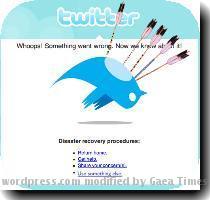Study concludes newspapers remain the main source of original reporting despite financial woes
By Michael Liedtke, APMonday, January 11, 2010
Study: Newspapers still a step ahead in local news
SAN FRANCISCO — Most local news still flows from newspapers even as an Internet-driven upheaval diminishes the depth of their coverage, according to a study to be released Monday.
The findings are based on an analysis of how local news stories evolved in Baltimore during one week last summer. The review by Pew Research Center’s Project for Excellence in Journalism monitored 53 media outlets — newspapers, television and radio stations and Web-only operations.
Newspapers and their Web sites provided 61 percent of the original reporting or fresh information on six major news stories that unfolded during the week of July 19-25, the study found. Local television stations and their Web sites accounted for 28 percent of the new information, followed by radio stations and their sites at 7 percent and Internet-only “new media” at 4 percent.
The conclusions bolster the arguments of newspaper publishers and editors who trumpet their publications as indispensable sources of information about their communities.
J. Montgomery Cook, editor of The Baltimore Sun, wishes the study would have examined more than just a one-week window. A longer look “would have more clearly proven how dominant and comprehensive The Sun is compared to other media,” Cook wrote in an e-mail.
Yet The Sun and other big newspapers are getting smaller as their print editions lose readers and advertisers to the Internet.
Part of the problem, according to the most outspoken media executives, is that the newspaper industry has been losing hundreds of millions in revenue annually to Google, blogs and other Web sites that crib from their stories to help attract more readers and sell more advertising. The contingent making this argument include News Corp. Chairman Rupert Murdoch, whose company owns The Wall Street Journal, and Tom Curley, chief executive of The Associated Press, a not-for-profit cooperative owned by newspapers.
“This study does suggest that if newspapers were to disappear, what would be left to aggregate?” said Tom Rosenstiel, director of the Project for Excellence in Journalism.
Media blogger Jeff Jarvis, who wrote a book hailing Google’s business practices, thinks it’s premature to pose that question. He is teaching a City University of New York graduate journalism class on the future of digital reporting, partly because be believes printed newspapers are doomed.
“We can improve the (Internet’s) ecosystem for covering local news,” Jarvis said. “We’re still in the pre-dawn era of this transformation.”
Television news coverage also has been reduced in recent years. In reaction to declining ratings in the evening, TV stations are programming more newscasts in the early morning and other hours, Rosenstiel said, a trend that’s taxing their staffs because they usually aren’t hiring more workers. To save money, TV newscasts are relying more on narrative accounts read in the studio instead of sending reporters to news scenes, Rosenstiel said.
Local TV stations churned out slightly more content, either on the air or on their Web sites, than newspapers, according to the study. Fewer of the stories, though, contained original reporting, with TV stations often pulling information from other media, primarily newspapers.
Overall, more than 80 percent of the coverage published and broadcast during the study period contained old information wrapped in a different package. “Much of the ‘news’ people receive contains no original reporting,” the study found.
More commonly than in the past, the study found, press releases from politicians, government agencies and companies were rewritten quickly by multiple outlets and posted on the Web with no additional reporting.
Newspapers often updated their stories with more information later in the day or published a more thorough report in the print publication, Rosenstiel said. But the first versions on the Web tended to attract a lot of traffic, partly because of the way links to news are increasingly distributed on Twitter’s short messaging system and social networks such as Facebook, according to the study. In some cases, the stripped-down news reports initially posted on the Web weren’t updated, leaving an incomplete picture.
What’s more, the report contends newspapers aren’t digging as deeply into local stories or producing as much coverage as they did before the Internet’s less expensive advertising alternatives and the recent recession ravaged their revenue.
Print ad sales, the main source of newspaper income, have plunged by more than 40 percent — siphoning more than $20 billion in annual revenue — since 2005.
Those financial pressures triggered layoffs that have collectively reduced the size of U.S. newspaper staffs by about 25 percent since 2001, based on estimates from the American Society of News Editors. That translates into the loss of at least 14,000 newspaper reporters, editors and photographers in eight years. The final count on 2009 job losses hasn’t been completed.
Large dailies such as The Sun have been particularly hard hit. Its owner, the Tribune Co., has been operating in bankruptcy protection for the past 13 months. The Sun endured a nearly 30 percent staff cut last April that left its newsroom with about 150 employees.
For whatever reasons, the study found that fewer local stories are being published by the Sun and six other newspapers that cover the Baltimore area. The list includes other general-interest publications such as The Washington Post and the Towson Times and specialty publications such as the Baltimore Business Journal.
The change came into sharp focus in July when Maryland Gov. Martin O’Malley proposed deep cuts in the state’s budget. There were 26 stories published on the subject by the Baltimore-area newspapers monitored during the weeklong study, as well as the AP and other publications around the country. The last time Maryland announced substantial budget cuts in 1991, there were 83 stories published in a comparable weeklong period, according to the study.
Jarvis contends that less original coverage doesn’t necessarily translate into less information for readers, because the Web has enabled more people to post comments and links to other material that illuminate.
“Journalism today isn’t just about the production of content,” he said. “It’s about where we can all add value.”
Tags: Baltimore, Computing And Information Technology, Internet Technology, Journalism, Maryland, North America, Online Media, Online News Media, San Francisco, United States





